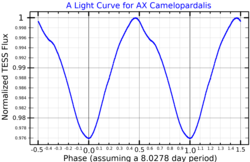Astronomy:53 Camelopardalis
| Observation data Equinox J2000.0]] (ICRS) | |
|---|---|
| Constellation | Camelopardalis |
| Right ascension | 08h 01m 42.43137s[2] |
| Declination | +60° 19′ 27.8016″[2] |
| Apparent magnitude (V) | 6.02[3] (6.3 + 7.5)[4] |
| Characteristics | |
| Evolutionary stage | main sequence |
| Spectral type | A3VpSrSiCrEu[5] |
| B−V color index | 0.158±0.005[3] |
| Variable type | α2 CVn[6] |
| Astrometry | |
| Radial velocity (Rv) | −2.2[3] km/s |
| Proper motion (μ) | RA: −21.367[2] mas/yr Dec.: −26.386[2] mas/yr |
| Parallax (π) | 11.2327 ± 0.1547[2] mas |
| Distance | 290 ± 4 ly (89 ± 1 pc) |
| Absolute magnitude (MV) | 1.05[3] |
| Orbit[7] | |
| Period (P) | 2,422.04±2.42 d |
| Eccentricity (e) | 0.718±0.012 |
| Periastron epoch (T) | 2,427,723.6±14.3 JD |
| Argument of periastron (ω) (secondary) | 5.22±1.64° |
| Semi-amplitude (K1) (primary) | 12.08±0.45 km/s |
| Details[7] | |
| 53 Cam A | |
| Mass | 2.074±0.012 M☉ |
| Radius | 2.36±0.10 R☉ |
| Luminosity | 24.9±1.15 L☉ |
| Surface gravity (log g) | 3.70±0.10 cgs |
| Temperature | 8,400±150 K |
| Rotation | 8.02681±0.00004 d |
| Rotational velocity (v sin i) | 12.5±0.5 km/s |
| Age | 615+56 −51 Myr |
| Other designations | |
| Database references | |
| SIMBAD | data |
53 Camelopardalis is a binary star system in the northern circumpolar constellation of Camelopardalis,[8] located 290 light years away from the Sun as determined by parallax measurements.[2] It has the variable star designation AX Camelopardalis; 53 Camelopardalis is the Flamsteed designation.[8] This object is dimly visible to the naked eye as a white hued star with a baseline apparent visual magnitude of +6.02.[3] It is a single-lined spectroscopic binary[9] system with an orbital period of 6.63 years and a high eccentricity of 0.718.[7] The "a sin i" value of the primary is 280 Gm (1.9 astronomical unit|AU), where a is the semimajor axis and i is the orbital inclination.[7]
The visible component is a well-studied magnetic Ap star[7] with a stellar classification of A3VpSrSiCrEu[5] and a visual magnitude of 6.3.[4] The magnetic field topology of 53 Camelopardalis is complex, and is accompanied by abundance variations across the surface of elements like silicon, calcium, titanium, iron, and neodymium.[7] It is classified as an Alpha2 Canum Venaticorum type variable star and the combined brightness of the system varies from magnitude +6.00 down to +6.05 with a rotationally-modulated period of 8.0278 days.[6]
The primary has 2.1 times the mass of the Sun and 2.4 times the Sun's radius. It is spinning with a projected rotational velocity of 12.5 km/s and a rotation period of 8.0268 days. The inclination angle of the pole is estimated to be 57°±5°. The star is about 615 million years old and is radiating 25 times the luminosity of the Sun from its photosphere at an effective temperature of 8,400 K.[7]
References
- ↑ "MAST: Barbara A. Mikulski Archive for Space Telescopes". Space Telescope Science Institute. https://mast.stsci.edu/portal/Mashup/Clients/Mast/Portal.html.
- ↑ 2.0 2.1 2.2 2.3 2.4 2.5 Brown, A. G. A. (August 2018). "Gaia Data Release 2: Summary of the contents and survey properties". Astronomy & Astrophysics 616: A1. doi:10.1051/0004-6361/201833051. Bibcode: 2018A&A...616A...1G. Gaia DR2 record for this source at VizieR.
- ↑ 3.0 3.1 3.2 3.3 3.4 Anderson, E.; Francis, Ch. (2012), "XHIP: An extended hipparcos compilation", Astronomy Letters 38 (5): 331, doi:10.1134/S1063773712050015, Bibcode: 2012AstL...38..331A.
- ↑ 4.0 4.1 Malkov, O. Yu. et al. (2012), "Dynamical Masses of a Selected Sample of Orbital Binaries", Astronomy & Astrophysics 546: 5, doi:10.1051/0004-6361/201219774, A69, Bibcode: 2012A&A...546A..69M
- ↑ 5.0 5.1 Abt, Helmut A.; Morrell, Nidia I. (1995), "The Relation between Rotational Velocities and Spectral Peculiarities among A-Type Stars", Astrophysical Journal Supplement Series 99: 135, doi:10.1086/192182, Bibcode: 1995ApJS...99..135A
- ↑ 6.0 6.1 Samus, N. N. et al. (2017), "General Catalogue of Variable Stars", Astronomy Reports, 5.1 61 (1): 80–88, doi:10.1134/S1063772917010085, Bibcode: 2017ARep...61...80S.
- ↑ 7.0 7.1 7.2 7.3 7.4 7.5 7.6 Carrier, F. et al. (October 2002), "Multiplicity among chemically peculiar stars. II. Cool magnetic Ap stars", Astronomy and Astrophysics 394: 151–169, doi:10.1051/0004-6361:20021122, Bibcode: 2002A&A...394..151C.
- ↑ 8.0 8.1 8.2 "53 Cam". SIMBAD. Centre de données astronomiques de Strasbourg. http://simbad.u-strasbg.fr/simbad/sim-basic?Ident=53+Cam.
- ↑ Kochukhov, O. et al. (February 2004), "Magnetic Doppler imaging of 53 Camelopardalis in all four Stokes parameters", Astronomy and Astrophysics 414 (2): 613–632, doi:10.1051/0004-6361:20031595, Bibcode: 2004A&A...414..613K
 |


